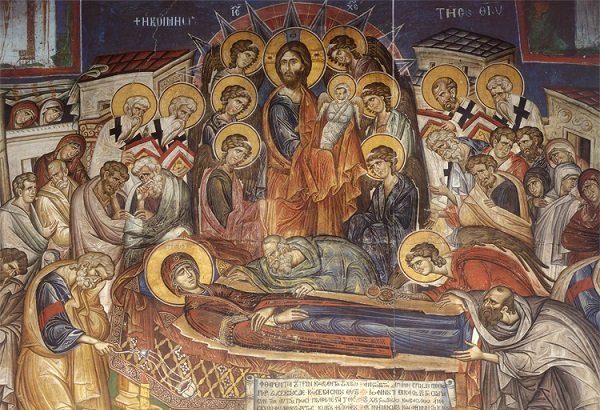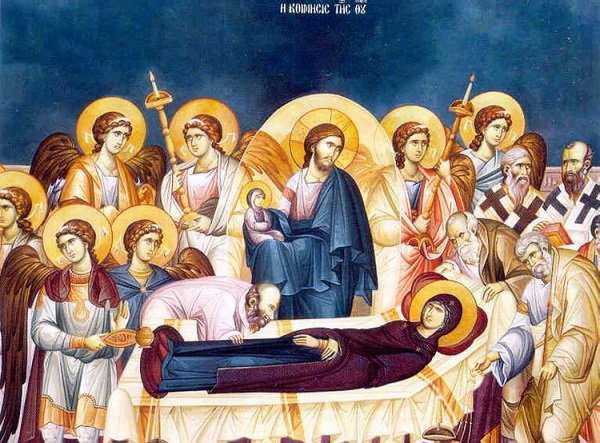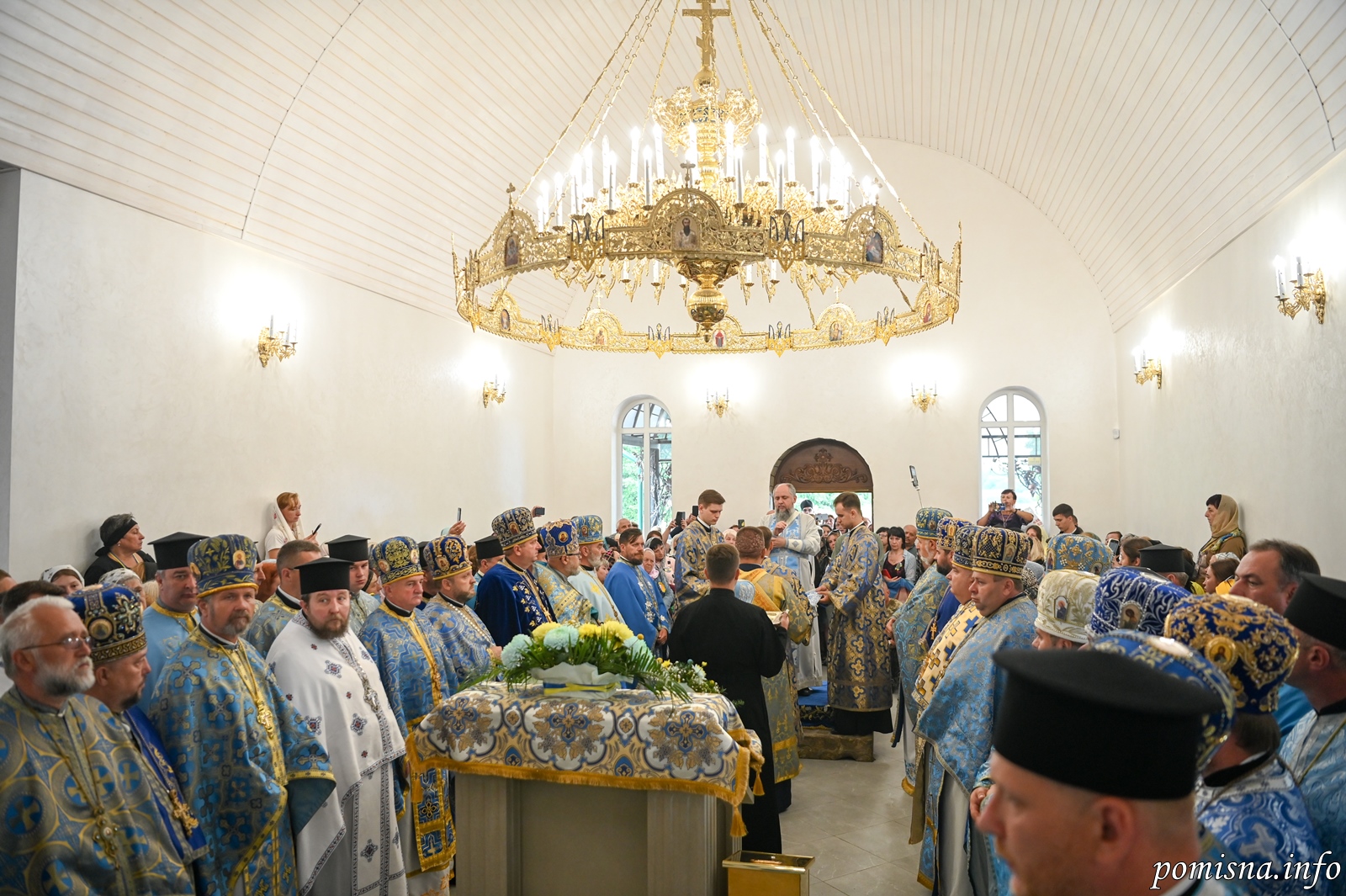The Dormition of the Mother of God – Transition to Life


Every time we celebrate the Dormition of the Mother of God it’s as though we have Easter again. The summer Easter. Our Lady the Mother of God prepares Easter for us. A glorious crossing ‘from death to life’. A second Easter, holy, spotless, giving life to the human race, because today, in truth ‘ the laws of nature are overcome’.
Saint John the Damascan declares: ‘How the source of life goes to life, passing through death’. The death of the ‘life-giving Mother’ of the Lord surpasses the notion of death, so that it’s not even called death, but rather ‘dormition’, and ‘divine transition’ and a departure towards or arrival in the Lord. And even if it’s called death, it’s still a death which brings life, since she makes the transition to celestial and eternal life.
This transition of the Mother of God, as an undeniable fact, preserved by holy Tradition, has been incorporated into the teaching of the Orthodox Church and has no relation to the pious doctrines of the West concerning immaculate conception and the Mother of God’s life without death.
The Virgin was the special creation of God, who surpassed all people and all angels. Of all humankind, she alone led a spotless life and- beyond the understanding of all rational beings- became the Mother of God. Since she never sinned, she rightly never submitted to any thoughts of pleasure, nor did she live on earth with the pleasures of the flesh or with illness. Even though she had the body which gave life to the Lord, still, as a human person, she was subject to the sickness of death and did, indeed, die. But her soul was not separated from God and neither was her body.
For a short time, the bond linking them together was loosed, as had been the case with Christ. After death, her soul was immediately united with Christ. Because, at the hour of His Mother’s dormition, the Lord, accompanied by the celestial hosts and the saints, took her holy soul not simply to heaven but ‘to His royal throne, to the celestial Holy of Holies’, as Saint John the Damascan tells us. And then, after three days, the life-giving and God-receiving body of Our Lady was translated, without decay, to realms above the heavens, to her Only-Begotten and beloved Son. It’s therefore appropriate to talk of the resurrection of the Mother of God in the body, though this resurrection was not initiated by Our Lady herself, but by her Son and God.
One witness of this resurrection, this transition of the Mother of God, was the Apostle Thomas, who wasn’t present at her holy burial, but, as usual, arrived late, in this case by three days. At his request, the other Apostles opened the grave but didn’t find the body which had been glorified by God. They did, however, see the Mother of God ascending into heaven, and she gave the Apostle Thomas her belt as proof of her translation. This was rather similar to what had happened when the same man had needed to touch Christ after the Resurrection.
As was the case with her Son, the body of the Mother of God did not suffer any disintegration in the grave. In other words, it wasn’t changed and the material elements which constituted it didn’t dissolve. In any case, since Christ’s Resurrection, the bodies of many of the saints have not decayed and have become partially incorrupt relics. So it’s more than reasonable, then, that the ‘life-receiving dwelling’ which was the Mother of God would not decompose.
Saint Andrew of Crete says that the preservation of the virginity of the Mother of God during the birth of Christ had as its natural concomitant the incorruption of her body at the hour of her death. ‘Birth avoided any abrasion and the grave would not accept decomposition’.
After her dormition, Our Lady became the Mother of the new creation, of the Church of Christ. Since she had the central position in God’s dispensation for our salvation (because the Lord, Who is the head of the Church, became incarnate through her), she now has, in the celestial Church, all the fulness of Grace, glory and boldness. She’s become the benefactress of nature and creation, which is why she’s venerated by the whole of creation as Lady, Maiden, Queen and Mother of God.
Through the Mother of God, and because of her, the history of the whole world entered upon a new path, incomparably more magnificent and superior to that which had existed before her. Nothing could or ever can become more perfect than she, nor could she herself become more perfect than she is. According to the Fathers, there are three things that our all-powerful God couldn’t improve on: the incarnation of His Word; the Virgin Mother of God; and the bliss that is to be enjoyed by those who are saved.
After the resurrection of Christ, Our Lady was the support of the apostles and the newly-founded Church. It was she who taught the new Christians, guided them and comforted them in their sorrows. In her Life we read that, three days before her dormition, the angel Gabriel visited her, as he had done at the Annunciation, and announced her glorious translation from death to life. Thereafter, in miraculous fashion, the Holy Spirit gathered all the apostles in Gethsemane, at the house of the Mother of God, so that they could obtain her blessing and be present at the funeral. After they had sung praises to the Mother of God, they asked her to grant them a final teaching, as a legacy.
She then told them a parable in which this world was likened to a trade fair and those who made the most favourable transactions, that is those who made the best buys, were the ones who would make the most profit. She went on to tell them that the same is true spiritually. Those who observe Christ’s commandments most strictly and zealously will have the greatest gain and will be glorified more in the kingdom of heaven. She urged them to persist in the ‘good struggle’.


Our Most Holy Lady really is so pleased when she sees us working for our salvation. It’s a great satisfaction to her. But how greatly she herself laboured on earth, in an unobtrusive manner. Since she was sinless she didn’t need to, but did so to leave us an example of perfect asceticism. After her dormition they found in Gethsemane, where she lived, that there were indentations in the stone slabs from friction and long usage, from her prostrations.
Let us also imitate her instant obedience, her charming humility, her mystical internal spiritual labours, her ardent prayer, the constant vigilance which she always exercised, her divine love and the spiritual pain which cut her like a knife at the Cross of her Son.
To those who engage in the struggle, she becomes an ‘invincible ally’, irrespective of whether they previously lived profligate lives. We should also remember that the Mother of God became the ‘Guarantor’ for Saint Mary the Egyptian as regards her repentance. And after Saint Mary retreated into the desert, where she strove uncompromisingly, Our Lady herself consoled her through her divine manifestations.
As the protectress of monastics, it is also she who grants the divine graces to them, particularly to the Athonites. She it was who gave the gift of the prayer of the heart to Saint Maximos Kavsokalyvis, Saint Gregory Palamas, Saint Silouan the Athonite and also to the late Elder Iosif the Hesychast, who has a direct link to our brotherhood. There’s another reason why today is of particular significance for us spiritual grand-children of Elder Iosif the Hesychast, because it was the day when, in 1959, he fell asleep in the Lord, after the Divine Liturgy. He loved Our Lady so much- he called her his sweet little mother- and received so many insights, divine manifestations and gifts from her. Indeed, a major characteristic of the blessed Athonite Fathers was their affection for the Mother of God. At the mere mention of her name, they were unable to restrain their tears, the result of love for the all-pure Virgin. The mere recollection of the Mother of God, that is the intellectual absorption with the person of the Mother of God, sanctifies those who engage in it. The late Fr. Athanasios Iviritis used to say that love for the Mother of God saves people, even if they’ve done no works.
People today should make use of the mediation of the Mother of God, which is for their salvation. Whatever their sorrow or problem, they should not forget that she is the ‘help of the grieving, the protectress, the defender, and the consolation of the daunted’. They can turn to her and find comfort and an immediate solution and answer. We pray that Our Lady the Mother of God, who ‘has passed over into life’ will always give her blessing to all of us, so that we may pass through this present life unharmed, as far as possible, unendangered by the deceptions and machinations of the evil one, and that we may be made worthy of the heavenly kingdom of her Son. Amen.
Source: pemptousia.com




